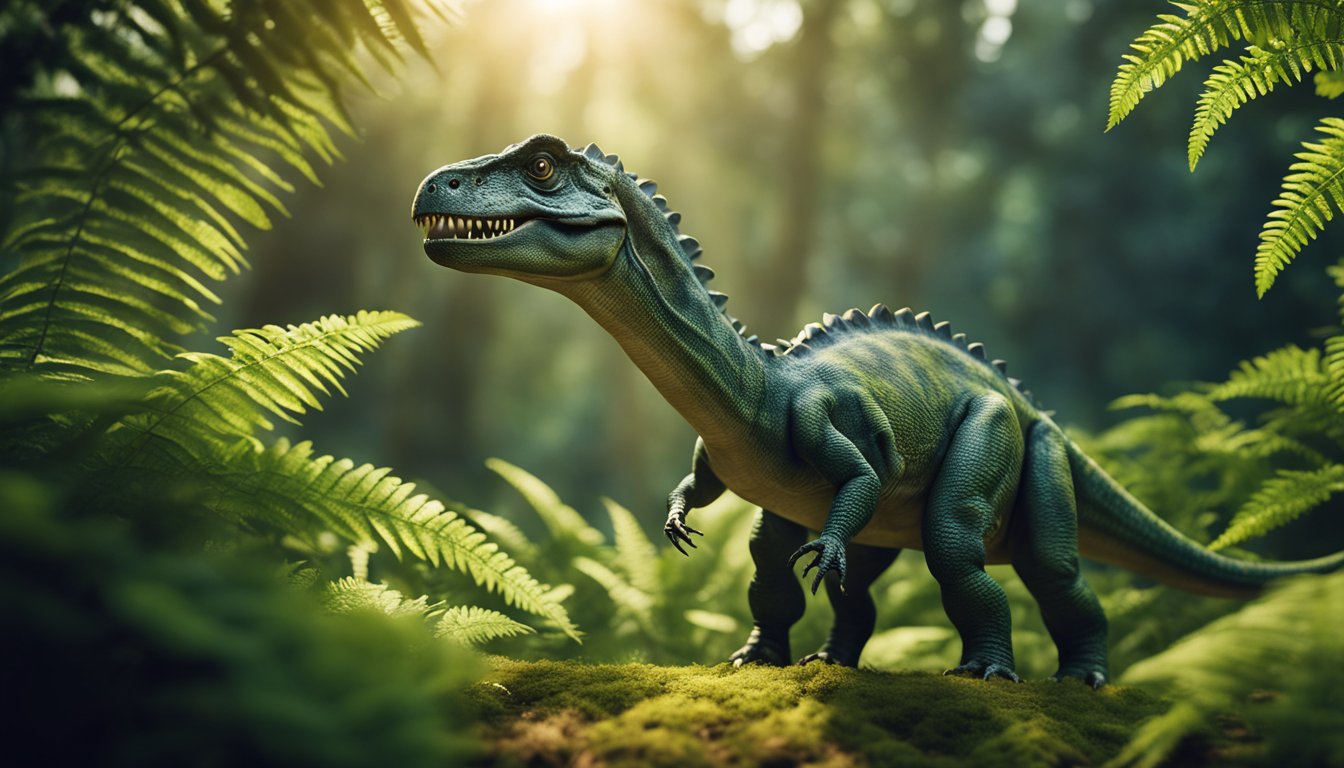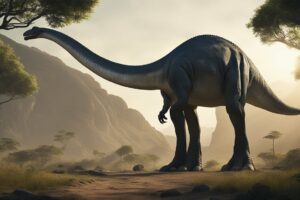Kaprosuchus, the boar crocodile with tusk-like teeth, is one of the most fascinating prehistoric creatures that ever lived.
This ancient crocodile roamed the earth during the Middle Cretaceous period, approximately 100 to 95 million years ago.
It was first discovered in Africa by paleontologist Paul Sereno in 2009, and since then, it has captured the imagination of scientists and animal lovers alike.

Kaprosuchus was a ferocious predator with a unique set of teeth that resembled those of a wild boar.
These tusk-like teeth were not found in any other known crocodyliform and were used to catch and kill its prey.
Its forward-facing eyes meant that Kaprosuchus had a wider field of view, making it easier to locate its prey.
Despite its fearsome appearance, Kaprosuchus was a relatively small crocodile, measuring only six meters in length.
Unveiling Kaprosuchus: Discoveries and Characteristics
Kaprosuchus, also known as the Boar Crocodile, is a genus of mahajangasuchid crocodyliform that lived during the Late Cretaceous period, approximately 66 million years ago.
The first and only known specimen of Kaprosuchus was discovered in 2009 by paleontologist Paul Sereno in the Echkar Formation of Niger.
Fossil Findings and Initial Discovery
The fossilized remains of Kaprosuchus consist of a nearly complete skull measuring 507 mm in length, with a lower jaw that is 603 mm long.
The discovery of this fossilized skull is significant because it provides valuable information about the anatomy and behavior of this prehistoric creature.
Distinctive Features and Skull Analysis
Kaprosuchus is named after its distinctive snout, which resembles that of a wild boar.
Its dentition is also unique, with three sets of tusk-like caniniform teeth that project above and below the skull.
These teeth are divided into two pairs, with the upper pair fitting into notches in the lower jaw.
Paleontologists have analyzed the skull of Kaprosuchus to gain insight into its lifestyle and behavior.
Based on the size and shape of its skull, they estimate that Kaprosuchus was about 6 meters in length, making it one of the largest crocodyliforms of its time.
Its tusk-like teeth suggest that it was a predator that may have hunted dinosaurs, as well as other animals that lived in the Late Cretaceous period.
In conclusion, Kaprosuchus is a fascinating creature that provides valuable insights into the prehistoric world.
Its unique snout and dentition make it stand out among other crocodyliforms, and its size and behavior make it an intriguing subject for further study.
The Lifestyle of a Land Predator

Kaprosuchus, also known as the “Boar Crocodile,” was a prehistoric crocodile that lived in what is now North Africa during the Middle Cretaceous Period, approximately 100 to 95 million years ago.
Unlike modern crocodiles that are aquatic, Kaprosuchus was a terrestrial predator that roamed the land in search of prey.
Hunting Habits and Prey
Kaprosuchus was a carnivore that hunted a variety of prey, including dinosaurs and other small animals.
Its powerful bite and gape allowed it to capture and kill its prey with ease.
Kaprosuchus was also known to have a keen sense of smell, which it used to track down its prey.
Anatomical Adaptations for Terrestrial Predation
Kaprosuchus had several anatomical adaptations that allowed it to thrive as a land predator.
Its legs were longer and more muscular than those of modern crocodiles, enabling it to run at high speeds when chasing down prey.
Its teeth were also unique, with three pairs of tusks that resembled those of a wild boar.
These tusks were used for both defense and offense, allowing Kaprosuchus to take down even the largest of prey.
Overall, Kaprosuchus was a formidable predator that dominated the land during the Middle Cretaceous Period.
Its unique adaptations and hunting habits make it a fascinating subject for study and exploration.
Kaprosuchus in the Cretaceous Ecosystem

Coexisting with Dinosaurs
Kaprosuchus, the boar crocodile, lived during the Late Cretaceous period, approximately 100 to 95 million years ago, and coexisted with dinosaurs in the Gondwana supercontinent.
This crocodile was a top predator in its ecosystem and was likely an aquatic ambush predator, preying on fish, turtles, and smaller dinosaurs.
Despite its fearsome reputation, Kaprosuchus had to contend with competition from other predators such as Spinosaurus, a massive carnivorous dinosaur that also lived in the same region and time period.
Kaprosuchus had to adapt to survive in this ecosystem, and its unique tusk-like teeth were likely an adaptation for aquatic predation.
Environmental Adaptations and Survival
Kaprosuchus was well-adapted to its environment, which was characterized by a warm and humid climate with abundant water sources.
Its streamlined body and powerful tail made it an efficient swimmer, while its long snout and sharp teeth were perfect for catching prey underwater.
In addition to its physical adaptations, Kaprosuchus likely had behavioral adaptations that helped it survive in its ecosystem.
For example, it may have used stealth and camouflage to approach its prey undetected, or it may have used its powerful jaws to crush the shells of turtles to access their soft flesh.
Despite its impressive adaptations, Kaprosuchus eventually went extinct, along with the dinosaurs and many other species, at the end of the Cretaceous period.
However, its legacy lives on through the fossil record, which provides valuable insights into the natural history of our planet.
Fun fact: The name Kaprosuchus means “boar crocodile” in Greek, referring to its unusually large caniniform teeth, which resemble those of a boar.
Understanding Kaprosuchus: Classification and Evolution

Kaprosuchus, also known as the “boar crocodile,” is an extinct genus of crocodyliform that lived during the Middle Cretaceous period, approximately 100 to 95 million years ago.
The name Kaprosuchus comes from the Greek words “kapros,” meaning boar, and “soukhos,” meaning crocodile, referring to its unusually large caniniform teeth that resemble those of a boar.
Taxonomic Placement and Relations
Kaprosuchus belongs to the family Mahajangasuchidae, a group of neosuchian crocodyliforms that were endemic to Madagascar and Africa during the Cretaceous period.
Neosuchians are a diverse group of crocodyliforms that evolved during the Jurassic period and are still represented today by the extant crocodilians.
Kaprosuchus was initially classified as a notosuchian crocodyliform due to its similarities with the South American notosuchian baurusuchids.
However, subsequent studies have placed it within the Mahajangasuchidae family, which includes other African and Madagascan crocodyliforms such as Mahajangasuchus and Razanandrongobe.
Evolutionary Significance and Theories
The discovery of Kaprosuchus has shed light on the evolutionary history of crocodyliforms during the Cretaceous period.
The presence of mahajangasuchids in Africa and Madagascar, which were once connected as part of the supercontinent Gondwana, suggests that these crocodyliforms were able to disperse across large distances and adapt to different environments.
One theory suggests that the unusual teeth of Kaprosuchus and other mahajangasuchids were an adaptation for hunting small dinosaurs.
This theory is supported by the discovery of dinosaur bones with tooth marks that match those of Kaprosuchus.
However, other researchers have suggested that the teeth were used for display or as weapons in intraspecific combat.
Despite the many unanswered questions about Kaprosuchus and its relatives, their discovery has contributed significantly to our understanding of the evolution and diversity of crocodyliforms during the Cretaceous period.
Frequently Asked Questions

What unique traits did Kaprosuchus possess that distinguished it from other prehistoric crocodiles?
Kaprosuchus, also known as the “Boar Crocodile,” was a prehistoric crocodile that lived during the Late Cretaceous period.
One of the most distinctive features of Kaprosuchus was its tusk-like teeth that protruded from both its upper and lower jaws.
These teeth were so large that the skull had notches on both the upper and lower jaws, allowing the tusks to pass through when the crocodile’s mouth was closed.
Additionally, the tip of the snout was quite bulky, which may have served as a potential battering ram during hunting.
How large could a Kaprosuchus grow, and what implications does its size have on its behavior and habitat?
Kaprosuchus was a relatively large crocodile, measuring up to 20 feet in length and weighing over a ton.
Its size suggests that it was a top predator in its ecosystem, capable of taking down large prey such as dinosaurs.
Its habitat was likely near rivers and lakes, where it could easily hunt and ambush its prey.
Could Kaprosuchus move quickly on land, and how might its speed compare to modern-day crocodilians?
Kaprosuchus was not as well adapted to land as modern-day crocodilians, but it was still capable of moving relatively quickly on land.
Its legs were positioned more underneath its body than modern-day crocodilians, which allowed for more efficient movement.
However, it is unlikely that Kaprosuchus could have sustained a high speed for long periods of time.
What does the Kaprosuchus skeleton reveal about its lifestyle and hunting strategies?
The Kaprosuchus skeleton reveals that it was a powerful predator with a robust skull and strong jaws.
Its tusk-like teeth suggest that it may have used its mouth as a weapon to stun or knock down its prey before clamping down with its jaws and teeth.
Additionally, its bulky snout may have been used as a battering ram to further incapacitate its prey.
Are there any surprising abilities Kaprosuchus might have had due to its distinctive physical features?
Kaprosuchus’ distinctive physical features suggest that it was a formidable predator, capable of taking down large prey.
Its tusk-like teeth and bulky snout may have allowed it to hunt in a unique way compared to other crocodiles.
However, there is still much to learn about Kaprosuchus and its abilities.
How did the environment in which Kaprosuchus lived influence its evolution and physical characteristics?
Kaprosuchus lived in a diverse ecosystem that included large dinosaurs and other predators.
Its physical characteristics, such as its tusk-like teeth and bulky snout, may have evolved as adaptations to the unique challenges of this environment.
By studying Kaprosuchus and other prehistoric animals, scientists can gain a better understanding of how animals adapt to their environments over time.






